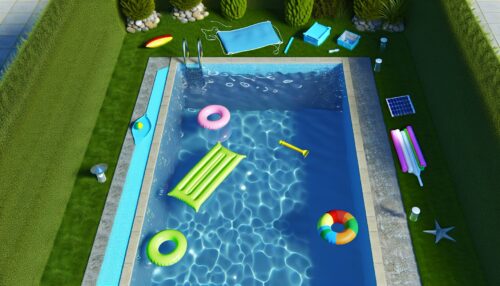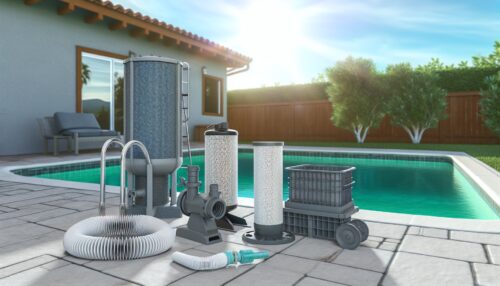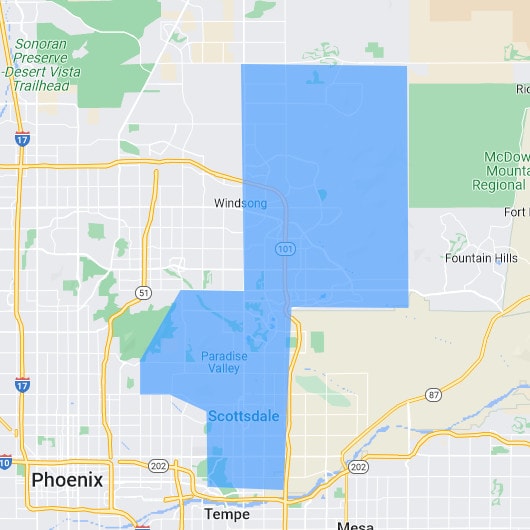Summer Pool Prep Tips for Scottsdale
Welcome to Summer: Preparing Your Pool in Scottsdale and Paradise Valley
As the temperatures in Scottsdale and Paradise Valley start to soar, there’s no better retreat than a refreshing dip in your pool. But before you dive in, a bit of preparation is needed to ensure your pool is safe, clean, and ready for the summer fun. From testing and balancing your pool chemicals to checking safety features and equipment, this guide covers the essential steps every pool owner should take. Whether you’re a new pool owner or a seasoned pro, you’ll find valuable tips to get your pool in top shape for the upcoming season. So, grab your sunscreen and prepare to make a splash in your perfectly prepared pool!
Table of Contents

Getting to Know Your Pool’s Basics Before Summer
Understanding your pool’s fundamental aspects is crucial before you enter the summer months. This foundational knowledge ensures that your pool is ready, safe, and enjoyable for everyone.
Know Your Pool Type
First, identify your pool type. Is it a freshwater or saltwater pool? The maintenance strategy for each type varies significantly. Saltwater pools, for example, require specific equipment and a slightly different approach to chemical balance.
Understanding the Pool Filtration System
Key Components:
– Pump: The heart of your pool, keeping water circulating and filtering.
– Filter: This captures and removes dirt and debris, ensuring clean water. Three types are common: sand, cartridge, and diatomaceous earth (DE) filters. Knowing which one you have is essential for proper maintenance.
Water Chemistry Basics
A balanced pool is a happy pool. Here are the primary water parameters you’ll need to keep an eye on:
– pH Level: Ideal range is 7.4 to 7.6.
– Alkalinity: It acts as a pH buffer. The ideal range is 100 to 150 parts per million (ppm).
– Sanitizer Levels: Whether you’re using chlorine or bromine, maintaining the correct sanitizer level is crucial for keeping the water clean and microorganisms-free.
Expert Tip: Invest in a reliable testing kit. Routine testing—ideally twice a week—allows you to catch and address any imbalance before it becomes a bigger problem.
Reviewing Your Equipment’s Manual
Don’t forget to brush up on your pool equipment’s manual. Each pool system has its quirks, and knowing how to operate your specific setup efficiently will save you time and headaches.
Understanding these basic aspects of your pool sets the stage for a safe and fun summer. Remember, a little preparation goes a long way. And if you need a hand with weekly pool maintenance in Scottsdale, we’re just a call away.
For more detailed information on maintaining your pool, check out this comprehensive guide from the Centers for Disease Control and Prevention (CDC) on residential pools.
Testing and Balancing Your Pool Chemicals
Getting your pool’s chemical balance right is like perfecting a recipe; it requires attention to detail and ingredients. Here’s how to ensure your pool’s chemistry is spot-on for the entire summer.
Why Balance is Key
A well-balanced pool means clear water, less wear on pool equipment, and, most importantly, a safe environment for swimmers. Imbalances can lead to problems like algae growth, irritated skin and eyes, and even damaged pool surfaces.
Steps to Perfect Pool Chemistry
– Test Your Water: Start by testing your water’s pH, alkalinity, sanitizer levels, and calcium hardness at least once a week. Use a reliable testing kit for accurate results.
– Adjust pH and Alkalinity: If your pH or alkalinity is off, adjust them using pH and alkalinity increasers. Aim for a pH level between 7.4 and 7.6 and alkalinity between 100 to 150 ppm.
– Sanitize: Ensure your chlorine or bromine levels are within the ideal range to kill bacteria and other pathogens effectively.
– Shock Your Pool: Weekly shocking helps to burn off dead chlorine cells, providing a clean slate for your sanitizer to work efficiently.
– Add Algaecide: Add algaecide to your regular maintenance routine to prevent algae blooms before they start.
Pro Tips
– Stay Consistent: Regular testing and adjusting keep your pool ready at all times.
– Record Your Results: Keeping a log of your test results and adjustments can help you better understand your pool’s needs and anticipate changes.
For those in Scottsdale and Paradise Valley, remember that summer temperatures can impact your pool’s chemical balance, making these steps even more crucial. And if you’re feeling overwhelmed, our pool equipment services can help maintain the perfect balance.

Clean-Up Crew: Pool Equipment Inspection & Cleaning
Ensuring your pool equipment is tip-top is key to a smooth summer. A thorough inspection and cleaning can prevent unexpected breakdowns from the pump to the filter during peak pool season.
Inspecting Your Pool Equipment
– Pump Check: Check the pump for signs of wear or leaks and listen for unusual sounds that might indicate it needs repair or replacement.
– Filter Inspection: Whether you have a sand, cartridge, or DE filter, check for any damage or excessive buildup. A clogged or faulty filter can lead to cloudy water and reduced filtration efficiency.
– Skimmer Baskets and Pool Cleaner: Inspect skimmer baskets regularly. If you use an automatic pool cleaner, ensure it’s running smoothly and debris-free.
– Heater Assessment: If you have a pool heater, ensure it’s functioning correctly. Look out for calcium scale buildup and corrosion, which can significantly reduce efficiency.
Cleaning and Maintenance Tips
– Backwashing the Filter: If you have a sand or DE filter, backwashing is a vital maintenance step to clear out trapped dirt and debris.
– Cartridge Filter Cleaning: For those with cartridge filters, remove and clean cartridges with a garden hose. If the cartridge shows signs of wear or damage, consider replacing it.
– Lubricating O-Rings: Apply silicone lubricant to the o-rings of the pump and filter to ensure a tight seal and prevent leaks.
– Professional Check-Up: A professional eye can sometimes catch issues you might overlook. Booking a pool equipment check-up before summer fully kicks in can save you from headaches later.
Ensuring your pool equipment is clean and functional improves water quality and extends the lifespan of your pool components. For more detailed instructions on cleaning your pool’s filter, visit the National Sanitation Foundation’s pool maintenance tips.
Winter’s Leftovers: Removing Debris and Thorough Cleaning
After the colder months, your pool likely collected a fair share of debris. A thorough cleaning sets the foundation for a sparkling summer pool.
Clearing the Surface and Bottom
– Skim Off Leaves and Debris: Use a leaf net to remove leaves, twigs, and other floating debris from the water’s surface.
– Vacuum the Pool: Vacuum the pool floor to pick up smaller debris and sediment the skimmer misses.
– Brush the Walls and Tiles: Algae and calcium can build up over time. Brush the pool walls, tiles, and steps to keep surfaces clean and smooth.
Managing the Water Level
– Check Water Level: It should be at the center of your pool skimmer. If it’s low, add water. If too high, drain the excess.
– Monitor After Cleaning: Cleaning can change the water level. Adjust as needed to maintain optimal levels.
Refreshing Your Pool Water
Even with chemicals, pool water can get “tired” after losing its sparkle and clarity. If your water looks dull, it might be time for a partial or complete water change. Refreshing your pool water can make a big difference in water quality.
Pro Cleaning Tips
– Consistent Schedule: Keeping up with debris removal and surface cleaning prevents bigger problems.
– Use a Pool Cover: When not in use, a pool cover can significantly reduce the amount of debris in your pool.
For a deeper dive into cleaning practices, the Consumer Product Safety Commission provides valuable safety and maintenance guidelines for pool owners.
Safety First: Checking Pool Safety Features
Ensuring your pool area is safe is just as important as keeping the pool water clean. Let’s dive into how to check that your pool’s safety features are operational.
Pool Fences and Gates
– Inspect Fences: Look for any damage or gaps a child could squeeze through. Fences should be at least four feet high.
– Check Gate Latches: Ensure gates self-close and self-latch at all heights.
– Secure Gate Locks: Locks should be out of reach of young children.
Pool Covers
– Examine Pool Covers: Check for wear and tear. Make sure the cover fits snugly over your pool to prevent accidents.
– Operational Check: If you have an automatic cover, ensure it opens and closes smoothly without obstructions.
Pool Alarms
– Test Alarms: If your pool has an alarm, test it to ensure it works correctly. This includes surface wave detection and gate alarms.
– Battery Check: Replace batteries at the start of the season to ensure they last through summer.
Emergency Equipment
– Accessible Rescue Equipment: Store life rings, ropes, and hooks within easy reach.
– First Aid Kit: Keep a well-stocked kit near the pool area.
– Emergency Procedures: Post emergency numbers and procedures in a visible location for quick reference.
Safety is a priority for a fun and worry-free pool season. Taking these steps protects your loved ones and gives you peace of mind. For further advice on pool safety, the Pool Safely campaign by the Consumer Product Safety Commission offers a wealth of information and resources to keep everyone safe around pools.

The Final Check: Inspecting Fences, Gates, and Covers
Before officially kicking off the pool season, it is crucial to check your pool’s fences, gates, and covers to ensure a safe and secure swimming environment.
Fences and Gates
– Stability: Ensure all fence posts are securely anchored in the ground. Wobbly fences could indicate weakened support.
– Integrity Check: Look for rust, loose screws, or broken parts in metal fences and rot or splinters in wooden fences. Repair any damage promptly.
– Clearance: Confirm there’s no more than a 4-inch gap between the ground and the bottom of the fence to prevent accidental entry by small children or pets.
Gate Latching Mechanisms
– Operational Test: Close the gate several times to ensure it latches correctly every time.
– Latch Condition: Check for rust, damage, or wear on latch mechanisms and replace if necessary.
– Self-Closing Feature: Test the self-closing feature of the gate to ensure it fully closes and latches from any position.
Pool Covers
Fit and Coverage: Verify that the pool cover covers the pool without sagging or gaps where children could slip under.
– Wear and Tear: Inspect for tears, holes, or fraying. A damaged cover might not support the weight of a child or pet and should be replaced.
– Mechanical Check: Ensure the mechanism operates smoothly and stops in the correct positions for automatic pool covers.
Paying attention to these details helps create a safer pool area. It’s about ensuring the fun in the sun stays uninterrupted by preventing accidents before they happen. Even with all the preparation in the world, supervision is key. Always keep an eye on swimmers, especially children, to ensure everyone stays safe.
Summer-Ready Tips and Tricks
With your pool almost ready for summer, here are some tips and tricks to ensure a seamless season of fun and relaxation.
Stay Ahead of Maintenance
– Weekly Testing: Monitor your water weekly to catch any chemical imbalances early.
– Routine Cleaning: Don’t let leaves and debris pile up. A clean pool is a happy pool.
– Equipment Check: Regularly inspect your equipment to prevent unexpected malfunctions.
Water Conservation
– Cover Up: Using a pool cover prevents evaporation, saving you money and conserving water.
Fix Leaks as soon as you spot them. Even a small leak can waste significant water.
Energy Efficiency
– Upgrade Equipment: Consider energy-efficient pumps and LED pool lights to reduce electricity usage.
– Solar Heating: Solar-powered options can be cost-effective and eco-friendly if you use a heater.
Health and Safety
– Sun Protection: Encourage the use of sunscreen to protect against sunburns. Remember to follow your dermatologist’s advice for staying safe in the sun. A good source for sun safety tips is the losangeles-dermatologist.com blog.
– Hydration Station: Keep plenty of water for swimmers to prevent dehydration.
Fun Enhancements
– Add Pool Floats: Brightly colored pool floats can add fun for all ages.
– Lighting: Install underwater lights for night swimming, adding safety and ambiance.
Remember these tips, and you’ll be set for a memorable summer by the pool. And if preparing your pool seems daunting, remember that we’re here to help with all your pool needs, from cleaning to repairs.
Explore Energy Saver tips on using swimming pool covers to conserve energy for innovative ways to enhance your pool experience.
FAQs
Got questions? We’ve got answers! Here are some of the most common questions pool owners in Scottsdale and Paradise Valley have as they prepare their pools for summer.
How often should I test my pool water?
– It’s best to test your pool water at least once a week. During heavy usage or extreme temperatures, consider testing more frequently.
How do I know if my pool filter is working correctly?
– Signs of a well-functioning filter include clear water, regular pressure gauge readings, and no signs of leakage. If you notice decreased water flow or cloudy water, it might be time for a cleaning or check-up.
Can I leave my pool uncovered all summer?
While it might be tempting, leaving your pool uncovered can increase debris and affect water balance. Using a cover reduces cleaning time and maintains water temperature.
What’s the best way to keep my pool safe?
– Ensuring your fence, gates, and pool alarms are in working order is key. Also, never leave children unattended in or around the pool.
How can I make my pool more energy-efficient?
– Upgrading to energy-efficient pumps, using a solar cover, and considering solar heaters can significantly reduce energy consumption.
Need more help getting your pool summer-ready? Don’t hesitate to reach out for professional advice and services.
Embrace a Splendid Summer by the Pool
With these tips in hand, your pool in Scottsdale or Paradise Valley is all set to be the centerpiece of your summer. From ensuring the chemical balance to keeping safety at the forefront, you’ve covered all bases for a season filled with joy, relaxation, and endless pool days. Remember, a well-maintained pool not only promises endless fun but also safeguards the health and well-being of your family and friends. So, here’s to diving into a splendid summer, knowing your pool is in perfect shape for every splash.
Don’t hesitate to reach out if you need more help or prefer to leave it to the experts. Our doors are always open to assist you with all your pool needs, ensuring you can sit back, relax, and enjoy your summer to the fullest. Here’s to a season of making a splash in a pool that’s not just ready but truly summer-perfect!




